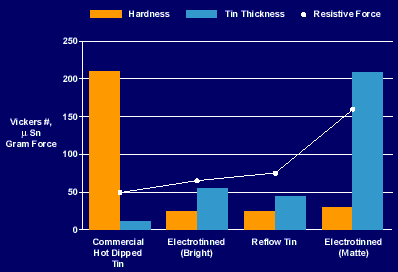The tin thickness strongly affects the force required to slide a hemispherical tinned contact over a similarly tinned flat surface (with loads of 250-750 gmf). The figure below shows that the Commercial Hot Dipped Tin surface (lowest tin thickness) provides the lowest resistive force. But Commercial Hot Dipped Tin also has the highest hardness (intermetallic effect), which could cause the lower resistive force. And, this markedly higher hardness of Commercial Hot Dipped Tin doesn't result in markedly lower resistive force, relative to Electrotinned (bright) and Reflow Tin. However, Electrotinned (matte) has markedly higher resistive force. This correlates well with its markedly higher tin thickness, and is explainable by the metal layers and structures.
Beneath the tin surface lies the quite hard Cu-Sn intermetallic (Vickers Hardness=300). The tin above this hard subsurface is much, much, softer. When this soft residual tin is relatively thin, deep "plowing" and its subsequent high resistive force is unlikely. But, when the residual tin thickness is relatively thick, deep plowing can and does occur, which can cause high insertion/withdrawal forces.
It's unfortunate that thicker tin causes higher insertion/withdrawal forces, because as was shown earlier, thicker tin is desirable to retard unwanted species in the substrate metal from diffusing to the surface. In addition, thicker tin lengthens the time for intermetallic to reach the surface.
The best tin thickness is that which is sufficient to provide a "pure" tin surface for the contact interface but is not thick enough to unduly affect insertion/withdrawal force. The best thickness is application dependent. However, the data in the previous figure provides some guidance. The tin on Electrotinned (bright) was 5 times thicker than that of Commercial Hot Dipped Tin while its resistive force was only 1.3 times as much. The tin on Electrotinned (matte) was similarly 4 times thicker than Electrotinned (bright), but its resistive force was 2.5 times as much. This indicates that a tin thickness above 50-in but less than 200-in may be effective for providing desirable contact properties without a disproportionate increase in insertion/withdrawal force.
 Figure 6 . Variables That Affect Insertion Force
Figure 6 . Variables That Affect Insertion Force